Centurion Narwhal, the Barbarians have arrived. Is your legion ready?
Well, cohorts are all over the place, in an inextricable confusion of cavalry, hastati and pikemen.
How come you… wait, you have Roman pikemen?
Absolutely! Genuine, honest-to-God, 16th century Roman pikemen.
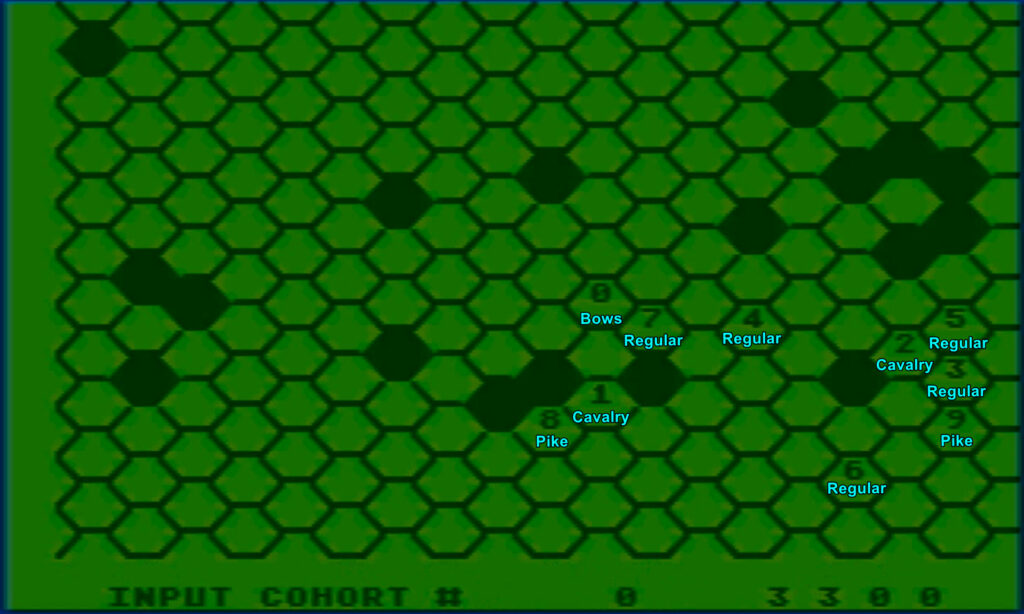
Robert Zdybel’s Centurion, released through the Atari Program Exchange (APX), is a minor game but one that’s interesting for two reasons :
- It is a simplified version of Crawford’s (now unavailable) first edition of Legionnaire for Commodore PET (1979), and as such Centurion gives us an insight into what Legionnaire was,
- As such, it is quite simply one of the first real-time wargames (under my definition) that has survived to this day.
Rob Zdybel probably had no problem publishing this game in the APX catalogue: he had been an employee of Atari since 1979. He had already developed, alone or not, various games including the famous Missile Command (an arcade game) and Stellar Track, yet another Star Trek clone. He managed to have four of his games included in the 15 games of the first APX catalog. In fairness, he did not really want to release some of those games (his adventure game Castle in particular had puzzles whose answers were inside jokes destined for his fellow Atari developers), but they were needed to flesh out the first APX catalogue to entice independent developers to submit their games.
It is in his capacity as Atari employee that Zdybel first saw Crawford’s Legionnaire : Crawford had brought the game with him as a portfolio reference when he was interviewing for a job at Atari. Zdybel liked the concept, while Crawford was at that point not interested in republishing his 1979 Legionnaire so he let Zdybel create his own version.
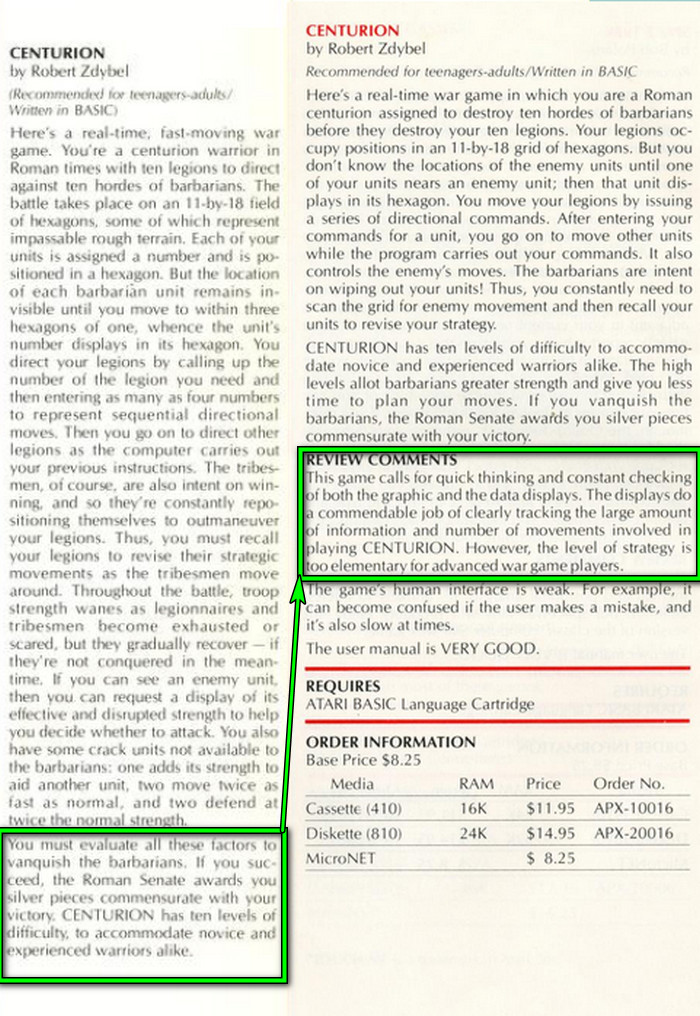
In Centurion, you command 10 Roman units (5 regulars, 2 pikemen, 2 cavalry and 1 archer) against a Barbarian force of the same size. The game generates a random map and a random troop placement, asks you which level of difficulty you want to play it, and there you are: leading your troops to glory and yourself to a cushy seat in the Senate while hoping the barbarians don’t come from a certain small village in Brittany.
The initial situation is total disorder. The units are all over the place, so my first task is to organize my troops in line. By the time the first barbarians are sighted, I have something of a line, with the pikes (better in defence) anchoring one of my sides.
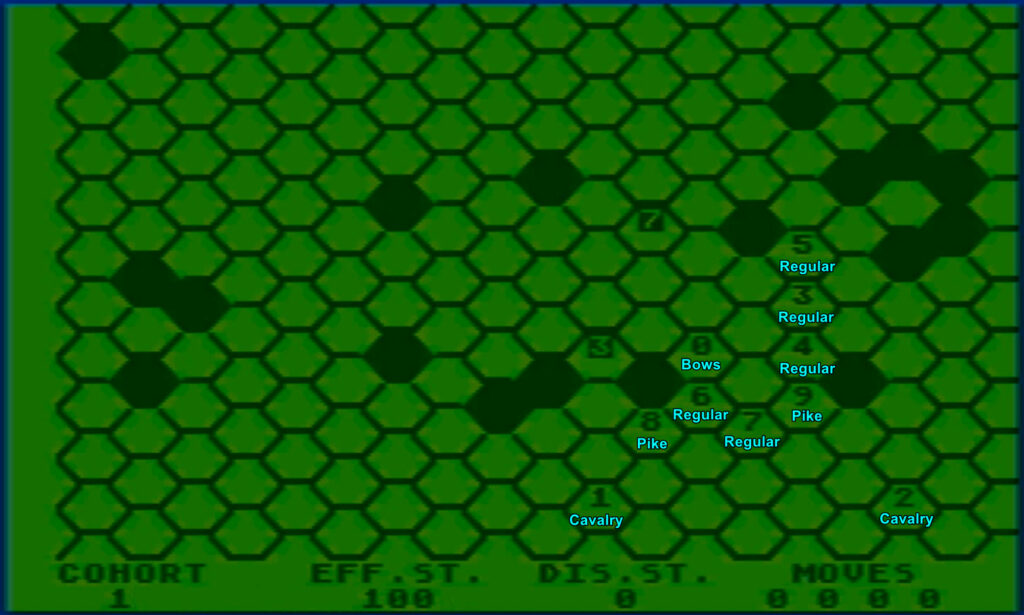
The deployment could have been better, my second unit of pikemen is not helping and my second unit of cavalry has not been moved yet.
Some barbarians (unit #3) try to pass between the two obstacles on the left, they are countered immediately by a charge of my cavalry, supported by my pikemen. The barbarian group is destroyed.

In the centre, the 7th group of Barbarians advances too much, and is destroyed by a counter-attack!
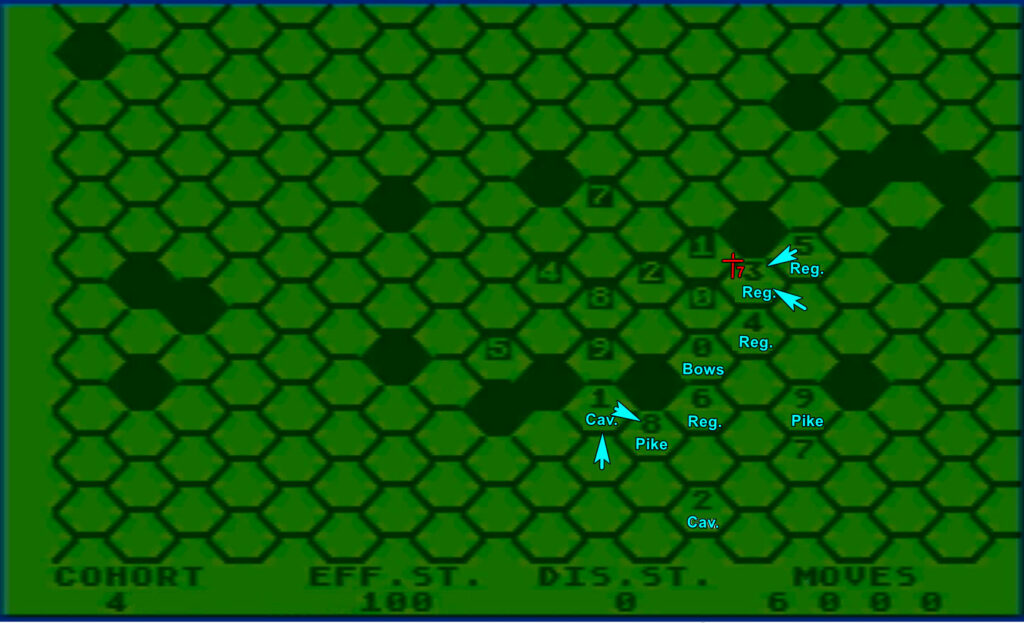
Sadly, my cavalry on the flank has been weakened somehow, and it is destroyed by the advancing #9. I send my second cavalry, but it is pushed aside. The Roman cavalry does not have a good reputation for a reason.
This is unlikely to matter much. In the centre, Barbarians have lost two groups that had decided that attacking a defensive position with 1:2 ratio was a smart move.
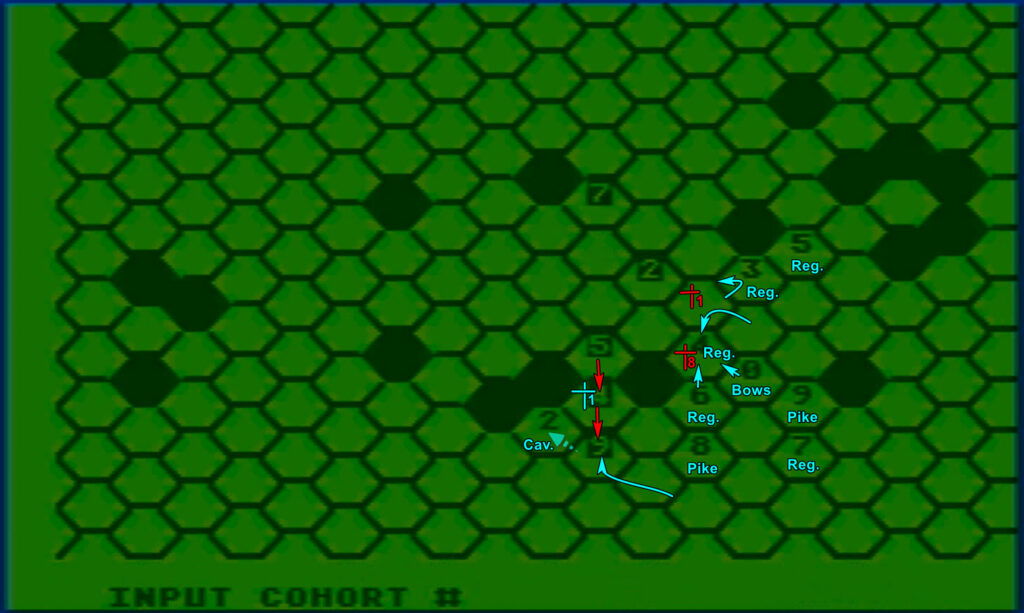
The barbarians on my left try to outflank me, but my pikemen were able to rest since their earlier battle and I know they are ready!
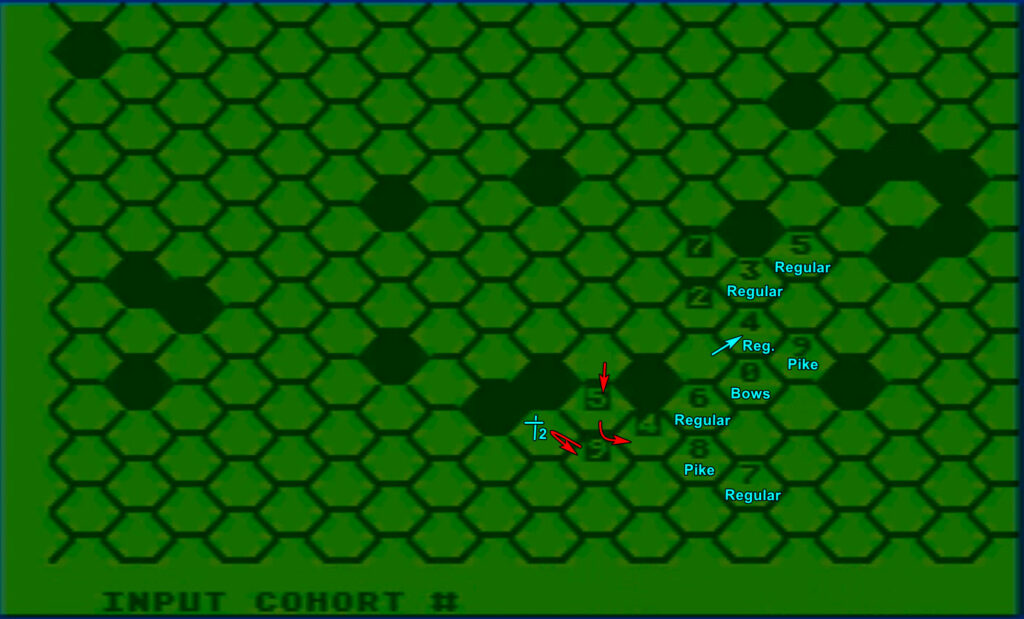
The barbarians crash against my lines, to no avail. I counter-attack, and most of the remaining barbarians are destroyed!
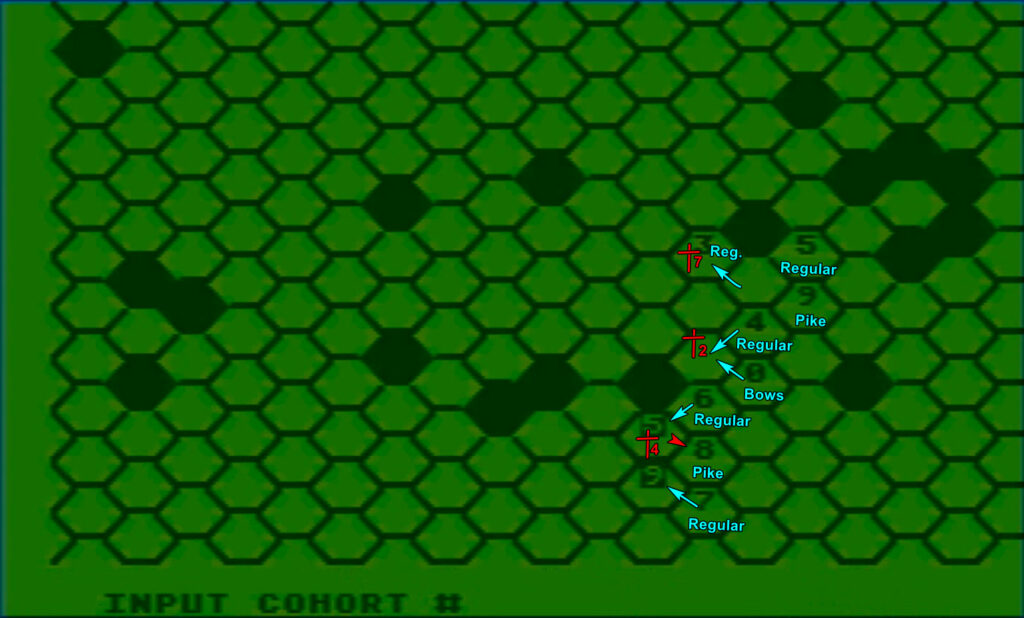
Against all odds, some barbarians manage to destroy one of my cohorts (#6)… but now they are both alone and surrounded :
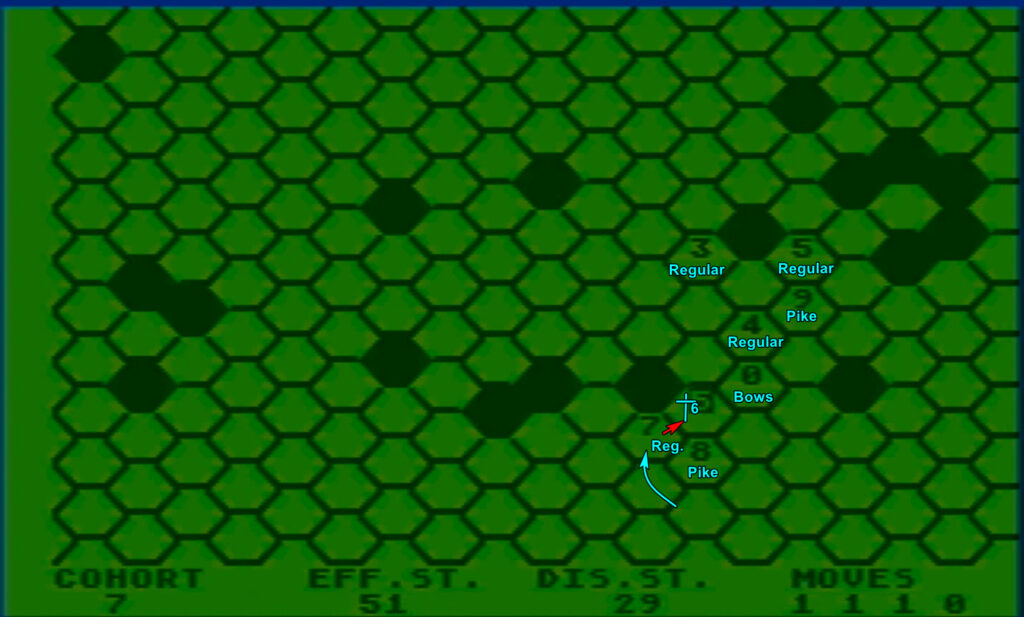
And eventually:
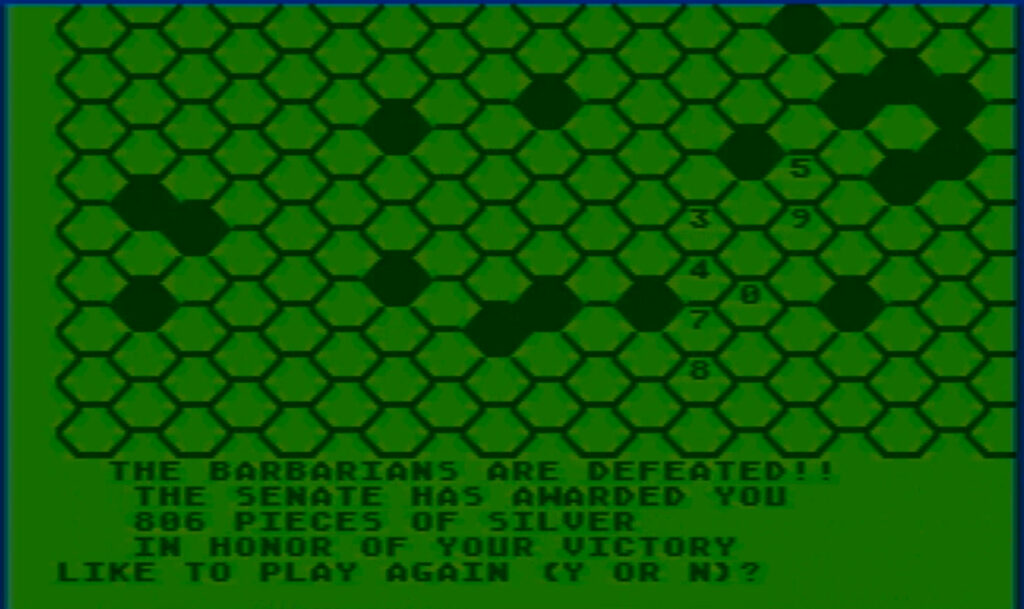
And that’s it. The battle lasted roughly 5 minutes, including a bit less than 2 minutes getting in position.
Rating & Review
Centurion by Robert Zdybel, published by APX, USA
First release: Summer 1981 on Atari
Tested on: Atari emulator
Total Hours Tested: 1 hour
Average duration of a battle: 5 minutes
Difficulty: Easy to play (1/5)
Would recommend to a modern player: No
Would recommend to a designer: No
Final Rating: Totally obsolete
A. Immersion
No context whatsoever, including in the manual. The description in the APX catalogue is all you will get.
The graphics are… well, spartan.
Rating: Terrible
B. UI , Clarity of rules and outcomes
In theory, the controls are easy: one key selects the cohort (from 0 to 9) and then the next four moves of the unit can be planned by pressing 1 to 6 for directions. Orders can be modified at any time.
In practice, it is quite difficult to play except in very static defence. There is no zone of control in this game, so very frequently a target just sidesteps your attack, which means you need to quickly select all the units in the area to give new orders – which in general you don’t have the time to do before the enemy moves again.
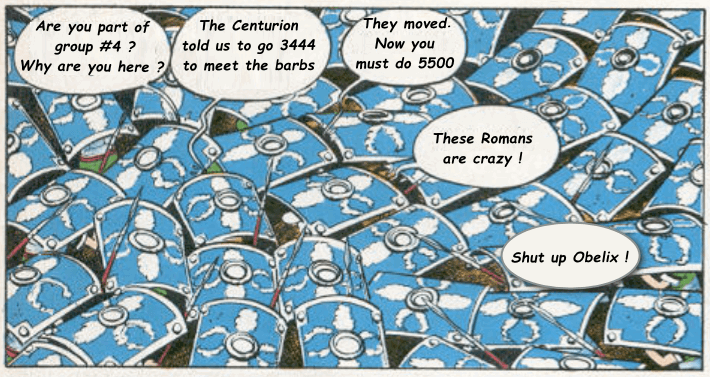
This is particularly frustrating for cavalry, which are terrible in defence: if you don’t give them an order to attack they will just stand there waiting for the enemy to kill them like Christian martyrs.
Rating: Very poor
C. Systems
Just like Legionnaire (and Eastern Front 1941), the game uses two stats: effective [max] strength and disrupted strength. A unit at 0 effective strength dies, and a unit at low disrupted strength retreats.
The problem is that both can go down very quickly, before you are able to react or do anything. The game allows units to retreat, but units retreat too late, and after they retreat they keep their previous orders, so if you had given them any offensive order they will do something stupid (like moving toward whatever they retreated from). In the unlikely case where you managed to save a damaged unit, their remaining max strength is going to be nominal.
There are 3 special units in the game, an addition compared to the 1979 Legionnaire :
- Pikemen, strong in defence, weak in attack. They are very useful,
- Cavalry, the opposite and also about twice as fast as other units. Problem: there is no facing in this game, and the AI attacks whatever is in range, so you cannot charge the enemy in its back, and when you are one tile away from the enemy with your cavalry, the enemy will attack you and exploit your cavalry’s pathetic defence.
- Archers, which automatically bring their strength in bonus to adjacent units, provided they are also adjacent to the enemy. Useful, but impossible to use in a fluid environment.
The combination of those issues means that you can only play the game in defence and try to exploit the AI to funnel it in locations where you can fight it 2 to 1.
Rating: Terrible
D. Scenario design & Balancing
You only get to choose the difficulty of the game from 1 to 9, which determines the maximum strength of the enemy and the speed of the game. I played at level 5. At level 7 or above, the barbarians are clearly full of magic potion and will almost immediately destroy your cohorts upon encountering them.
Unlike Crawford’s 1979 Legionnaire, you can only play the Romans.
The game randomizes the map and your position at the beginning, but there is not enough depth to want to play more than a few games.
The AI is aggressive, attacking even with badly weakened units but this is on purpose. Zdybel had issues with 1979 Legionnaire, where apparently you had to chase weakened enemy units across half the map.
Rating: Terrible
E. Did I make interesting decisions?
Not at all.
The only “decision” you make is your initial positioning, and even then I would not call that (or anything in this game) interesting. After that, the game is too much of a mess for anything to be impactful.
F. Final rating
Totally obsolete. At least battles are over in 5 minutes, so the game does not require a large investment for you, like say Tigers in the Snow does.
Contemporary Reviews
I could not find any, except those in the APX program. Even the Book of Atari Software ignored it. Crawford told me he forgot the game existed, and the game was just a blip in Zdybel’s video game career which carried on until 2007.
Be First to Comment